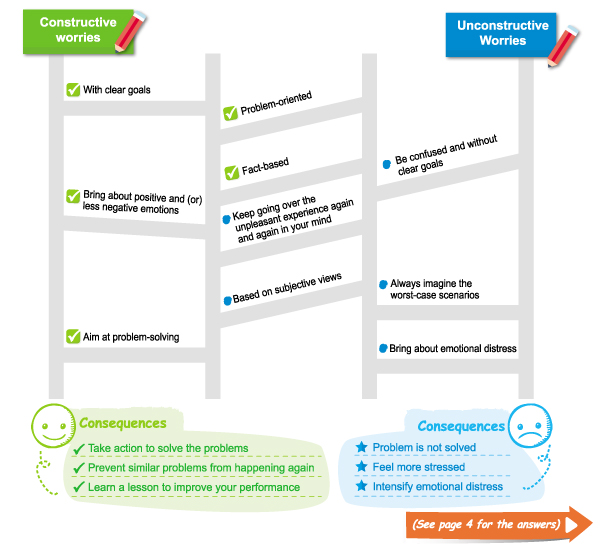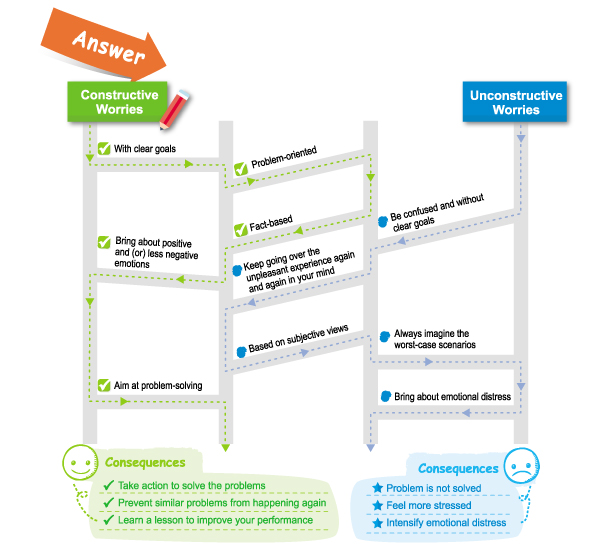Bridge
This Newsletter aims to promote communication between students and the Student Health Service of the Department of Health
September 2018 Issue No.76
Published by the Student Health Service, Department of Health
Time to Say Goodbye
First published in February 1996, the Bridge newsletter has been publishing 76 issues over the past 22 years. Time flies when the society is rapidly transforming and this will be the final issue of Bridge. We will continue to publish various health information on our website at www.studenthealth.gov.hk. Thank you very much for your support over the years and we look forward to your continued support to Student Health Service!
Editor’s Note
Students often encounter various challenges in the process of growing up. You either successfully overcame the challenges or believed that you haven’t done well - there is always something to learn from the experience. However, repetitive worries may sometimes bother you and cause overthinking, making you feel helpless when facing challenges. In this issue, our Clinical Psychologist will share with us the tips for dealing with these repetitive worries. We hope you can utilize these tips to reduce worries and overcome challenges!
STOP HAVING UNCONSTRUCTIVE WORRIES
1. CASE STUDY: JOHN AND MARY
When all other classmates are feeling a sense of relief after the exam, John has worrying thoughts running through his head for days.
“I shouldn’t have made those careless mistakes in exam!”
“I got no good grades in this exam and I will definitely do so next time. No good grades, no university admission. No university admission, no decent wages. No decent wages, no bright future!”
John keeps going over his worries again and again in his mind and even experiences a shortness of breath.
Mary took part in an inter-school debate competition two weeks ago. Her team scored lower than they expected and was unable to get through to the final. Mary has been thinking intensely about her own performance during the competition since.
“I could have won if I hadn’t missed the chance to present my rebuttals!”
“My teammates must think I am a burden to them. Sooner or later they will have an excuse to kick me out of the team and everyone will laugh at me.”
Mary is tossing and turning all night with recurring disappointment and worries.
When suffering from a setback, John and Mary keep going over their worries again and again in their mind and imagining the worst-case scenario, triggering their stress response and emotional distress.
Have you ever found yourself being stuck in such situation? Do you want to know how to deal with frustration and disappointment in yourself? Here are some strategies to help you out of your predicament.
2. CONSTRUCTIVE AND UNCONSTRUCTIVE WORRIES
Doing a self-reflection after experiencing a setback is a constructive thinking process that helps evaluate, solve and prevent problems and improve your performance.
However, if you keep going over your mistakes again and again in your mind and imagining the worst-case scenarios like John and Mary, you will only get trapped in the vicious cycle of experiencing emotional distress and be at a higher risk of emotional problems (e.g. anxiety, depression, etc.).
Therefore, it is important to learn how to effectively stop having repetitive unconstructive worries for maintaining our psychological wellbeing.
Play the game below to learn the differences between constructive and unconstructive worries.
Game Rules:
Choose the “Constructive Worries” line on the top, and follow this line downwards. When a horizontal or diagonal line is encountered, follow it to get to another vertical line and continue downwards until reaching the end of the vertical line. You will find out the consequences of having constructive worries there.
Next, choose the “Unconstructive Worries” line on the top, and follow this line downwards. When a horizontal or diagonal line is encountered, follow it to get to another vertical line and continue downwards until reaching the end of the vertical line. You will find out the consequences of having unconstructive worries there.

3. TIPS FOR HANDLING UNCONSTRUCTIVE WORRIES
- Identify your thoughts
Distinguish your worries between constructive and unconstructive worries. Imagine you are an outsider – try to calmly view your unconstructive worries as soap bubbles that are slowly flowing away. You neither pay attention to nor remove the bubbles. - Create a “worry time”
Create a 15 to 20 minute-“worry time” every day to review your worries. If you experience worries at other times, write down the worries first and then review them at the next designated “worry time”. - Distract yourself
Distract yourself from negative thoughts by doing something that is simple and pleasurable, for instance, watching videos, playing board games or hanging out with friends. - Change unconstructive thoughts
Change the unconstructive thoughts that pressure and worry you a lot, for example, “I should win the approval of other people”, “I will be well-liked only if I perform well”, etc. - Construct a self-talk
Remind yourself to think objectively. Ask yourself “Will I still worry about this a week, a month or a year later?”, “Have I overestimated the negative possibilities?”, etc. - Solve your problems
Take the initiative to evaluate and solve the problems that are worrying you. Focus on what you can learn from the mistakes and how you can improve yourself in the future. - Do exercise
‘Pleasure chemicals’ are released after exercise. These chemicals which improve concentration and regulate breathing can help you stay relaxed and combat stress.

Concluding Remarks
Can you now distinguish between constructive and unconstructive worries? When you encounter situations similar to that of John and Mary in the future, remember to utilize what you have learnt in order to reduce repetitive worries and maintain your psychological wellbeing.
This publication is produced by the Student Health Service, Department of Health.
Tel: 2349 4212 / 3163 4600 Fax: 2348 3968
Web site: www.studenthealth.gov.hk
If you have any comments, you may email our Edition Board at shsbridge@dh.gov.hk
If you have any comments, you may email our Edition Board at shsbridge@dh.gov.hk
(Revised in March 2018)